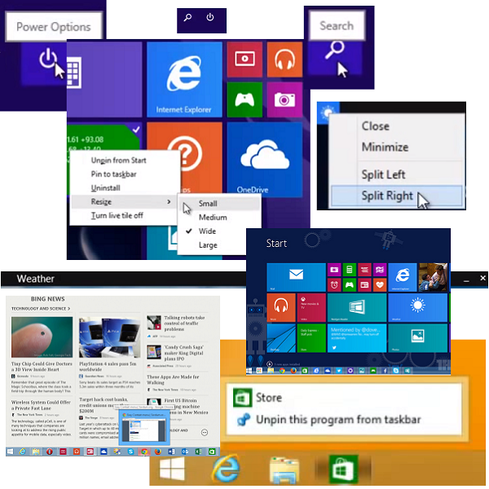Windows 8.1 Vs. iPads: Battle For The Classroom
Windows devices are starting to gain ground in school systems, a traditional Apple stronghold.


Windows 8.1 Update 1: 10 Key Changes
Windows 8.1 Update 1: 10 Key Changes (Click image for larger view and slideshow.)
With more schools looking to integrate technology into the classroom, the education market is more crowded than ever. Over the last few years, Apple's iPad has been a poster child for one-to-one deployment programs, which seek to put a computer or tablet in the hands of each student. Windows devices, however, have begun to mount a comeback.
Apple, Microsoft, and other tech companies have long considered students an important demographic, believing that if pupils embrace a certain technology in the classroom, they'll continue using it as adults. Recently, Apple has had more momentum than many competitors. When students returned to schools last fall, iPads controlled 94% of the US market for education tablets, according to research firm IDC. But thanks to agreements with some of the nation's largest school districts, Windows devices should play a bigger role this year.
The Los Angeles Unified School District (LAUSD) is the most high-profile new Windows customer. The nation's second-largest school system, LAUSD last year announced a much-hyped plan to spend up to $1 billion to equip its students with iPads. The district still plans to use iPads, but after experiencing a variety of problems with the initial rollout, LAUSD leaders decided to give students and teachers more options.
Administrators at 27 LAUSD high schools, or a little more than a quarter of all high schools in the district, can now choose from an expanded device lineup that includes not only Windows devices such as Microsoft's Surface Pro 2, Lenovo's Yoga, and Dell's Latitude E7420, but also Chromebooks. The new models will be tested in the fall before the district decides its next moves.
[While new versions of Windows gain ground, older versions of the operating system keep chugging along. Read Windows XP Stayin' Alive.]
LAUSD isn't the only large district that's recently embraced Windows 8.1. Following a two-year pilot, Pasadena Independent School District in Texas plans to deploy 12,900 of Dell's Venue 11 Pro 2-in-1 tablets, as well as Office 365. The district had originally considered a Windows 7-based program, but decided to go with the Windows 8.1-based Venue 11 Pro because of its stylus and digital ink capabilities.
Baltimore Country Public Schools will deploy 150,000 HP Elitebook 810 Revolve devices, meanwhile, and Fresno Unified School District, the fourth-largest in California, will issue 15,000 ASUS Transformer T1000 units to third- through eighth-grade students. Houston Independent School District and Miami Dade County Public Schools, both among the 10 largest districts in the nation, also plan to deploy tens of thousands of Windows 8.1 devices.
Even last year, when tablets were cannibalizing PC sales faster than anyone predicted, some schools had begun to reconsider iPads, reasoning that without a keyboard or desktop apps, Apple's tablets couldn't serve all needs. LAUSD came to the same conclusion.
The district's iPad program, whose initial costs were covered by a $30 million voter-backed bond, experienced a variety of problems. Some students complained the screen was too small for exams. Others struggled without keyboards. Still others managed to circumvent the district's security measures, and to access restricted apps such as YouTube and Facebook.
Dealing with these problems, as well as lost devices and miscommunication regarding the program's cost, LAUSD has scaled back its iPad deployments, at least for the moment. In the meantime, several schools are reportedly pleased with the new device options. According to a report in the LA Times, teachers who chose the new Windows options praised the versatile form factors of Windows 8.1 hybrids, as well as the opportunity to use styluses during instruction.
Though Microsoft and its partners have posted notable wins, Apple isn't backing down. Earlier this week, the company announced an update to iTunes U that will let teachers use the free iPad app to create, edit, and manage courses. Moreover, plenty of schools are still buying Apple products. Minnesota's St. Paul Public Schools, for example, just approved a multi-million dollar deal for thousands of iPads and MacBooks. There's also some evidence iPads have helped students achieve higher test scores.
The market is only getting more competitive. Samsung and Amazon are also building tablet-oriented education programs. Panasonic recently jumped into the ring as well, announcing not only its education-centric 3E tablet, but also complimentary projectors, interactive displays, and software. Google's Chromebooks, mentioned earlier, are also becoming popular low-cost options.
Ultimately, LAUSD board member Monica Ratliff probably has the best take on the growing diversity of options. "To have a one-device-fits-all approach does not make sense," she told the LA Times.
InformationWeek's June Must Reads is a compendium of our best recent coverage of big data. Find out one CIO's take on what's driving big data, key points on platform considerations, why a recent White House report on the topic has earned praise and skepticism, and much more.
About the Author(s)
You May Also Like
How to Amplify DevOps with DevSecOps
May 22, 2024Generative AI: Use Cases and Risks in 2024
May 29, 2024Smart Service Management
June 4, 2024







